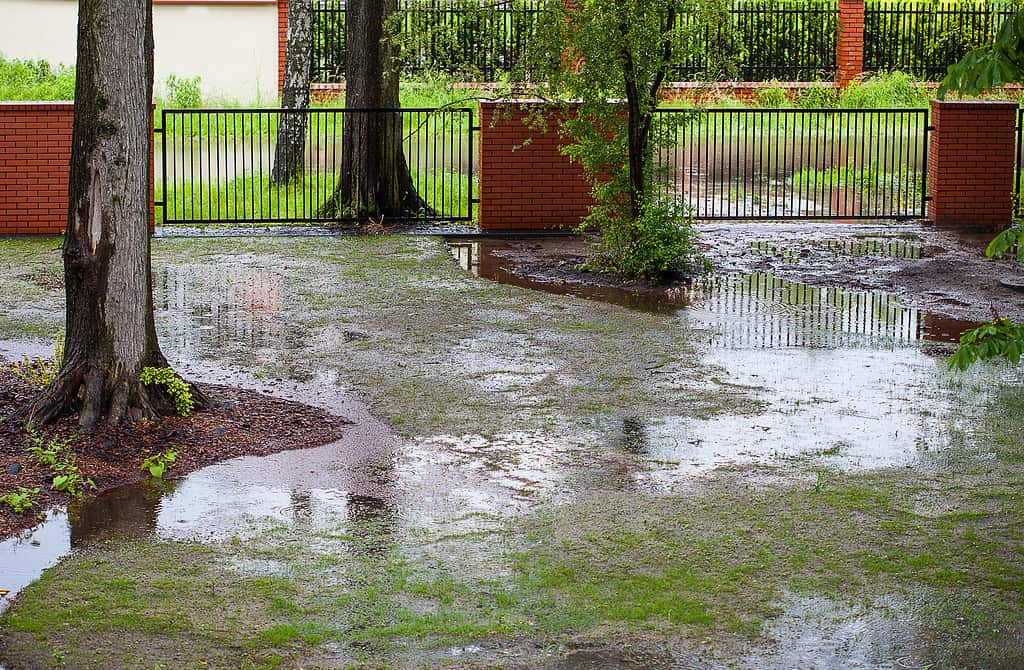Homeownership is a sought-after dream, but it can also come with a few nightmares along the way. One of these nightmares results from improper water drainage. This can lead to a flooded basement after heavy rains which can create more problems down the line. A proper drainage system can alleviate this issue, but how do you choose between a French drain and a curtain drain?
A French drain is meant to remove groundwater that is collecting around the surface level of a home and is mostly used for houses on a slope or hill. Curtain drains are made to address surface water and are relatively shallow compared to a French drain. Here’s what you should know about the differences between French and curtain drains and some tips to determine which one you should use.

The last thing you want is for your Livingroom to resemble the outdoors on a rainy day!
©KatarzynaBialasiewicz/iStock via Getty Images
What is a French Drain? Pros and Cons
A French drain is typically a trench fitted with a pipe that is covered in filter fabric and gravel. These pipes are typically located where groundwater accumulates. Like most other drainage systems, the French drain works via gravity to divert water downhill. They’re suitable for homes on hills or slopes, especially in areas prone to flooding. The pipes in a French drain often have perforations, which help drain the surrounding ground of water.
The person who brought this drain system into popular use was a Massachusetts native by the name of Henry French. French drains were originally developed to prevent crop fields from being flooded. They were eventually put into popular usage to prevent foundation damage and household flooding.
Some pros of the French drain include:
- Reduce flood risk
- Last up to 40 years
- They can be “hidden” with decorative rocks or plants, aiding in the aesthetic appearance of the yard.
But, there are some cons to consider, too:
- A long installation process involving digging trenches, so it can be unsightly for a while. This also means they can be expensive.
- Can be difficult to install around existing structures, leading to additional costs if you decide to temporarily remove these structures (think walkways, decks, established plants).
- Prone to clogging and filter fabric getting dirty. There’s also the possibly that roots can grow into the pipes, which can destroy them.
What is a Curtain Drain? Pros and Cons
A curtain drain is a shallow trench that has gravel in place of a filter, along with waterproof fabric lining the trench. Like a French drain, the main purpose of the curtain drain is to divert water away from structures. This can help preserve the integrity of structures like basements, foundations, or driveways.
Pros of a curtain drain:
- Easier to install than a French drain
- Reduces potential for property damage due to standing surface water
- Advantageous in areas with less precipitation/flood risk
The cons of a curtain drain:
- Not as useful under a heavy load of water
Though the cons list is shorter for a curtain drain, this doesn’t necessarily mean it’s the right choice for every homeowner. Take the precipitation, structures on the land, and soil into consideration when determining which drain system is best for you.
Key Differences

Both French drains and curtain drains are covered in gravel.
©Maryana Serdynska/iStock via Getty Images
Curtain drains and French drains are very similar, but not entirely the same. Though they work in almost the same way, each drainage system serves a different purpose. Here are the most important differences between the drains:
- A curtain drain is a shallow trench that diverts water away from the surface. A French drain is usually an underground system which diverts groundwater. A curtain drain uses gravel as a sole filter.
- French drains use filter fabric to filter out large particles and debris.
- A curtain drain is a shallow trench, and a French drain is a pipe with a 4-inch diameter.
- French drains are more useful for homes in areas that get a lot of heavy rain or for homes built on a slope.
Which Drain is Right for You?
A French drain is most suitable for homes in areas that get a lot of heavy rain at once, especially when it leads to flooding. Additionally, a French drain might be right for you if your home is on a hill or slope with water collecting in the basement or yard. However, some deep French drains are appropriate for houses on flat surfaces.
A curtain drain is better for homes where surface water is often a nuisance. If you have a lot of areas of pooling in your yard or driveway, a curtain drain will help alleviate these issues by diverting the water away from the house. However, they are not as useful as a French drain if you have issues with flooding or pooling in your basement.
The photo featured at the top of this post is © Mariana Serdynska/Shutterstock.com
Thank you for reading! Have some feedback for us? Contact the AZ Animals editorial team.







